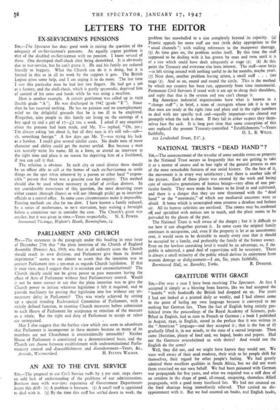AN AXE TO THE CIVIL SERVICE
SIR,—The proposal to cut Civil Service staffs by 5 per cent. steps shows an odd lack of understanding of the problems of our administration. Business men with war-time experience of Government Departments learnt this drill: (r) A problem is foreseen. (2) A small staff is appointed to deal with it. (3) By the time this staff has settled down to work, the problem has snowballed to a size completely beyond its capacity. (4) Frantic appeals for more staff are met (with delay appropriate to the "usual channels ") with stalling references to the manpower shortage. (5) As time goes on, the problem settles itself. By this time the staff supposed to be dealing with it has grown by ones and twos until it is of a size which could have dealt adequately at stage (a). (6) At this point the Treasury and everyone else loses interest. The staff—now large —is left sitting around with nothing useful to do for months, maybe years. (7) Next door, another problem having arisen, a small staff . . . (see stage (2). And so on, round and round the circle. This is the method by which our country has been run, apparently from time immemorial. Permanent Civil Servants if taxed with it are apt to shrug their shoulders, and reply that that is the system and you can't change it.
Big American industrial organisations have what is known as a "change staff " ; in brief, a team of strategists whose job it is to see that men are ready at the right time and place and in the right numbers to deal with any specific task and—equally important—are cleared out promptly when the task is done. If they fail in either respect they them- selves face the sack. It is long past time that some conception of this sort replaced the present Treasury-controlled "Establishments."—Yours


































 Previous page
Previous page